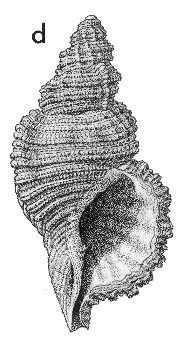
Revised descriptions of New Zealand Cenozoic Mollusca from Beu and Maxwell (1990)

 | Revised descriptions of New Zealand Cenozoic Mollusca from Beu and Maxwell (1990) | 
|
  (Pl. 48d): GS2189, R22/f6314, Castlecliff, Wanganui, Castlecliffian (GNS, early collection) |
Beu & Maxwell (1990): Chapter 16; p. 354; pl. 48 d.
Synonymy: Tritonium tabulatum Menke 1843, p. 25; Triton waterhousei A. Adams & Angas 1864, p. 35; Cabestana debilior Finlay 1930b, p. 59; Cabestana waterhousei segregata Powell 1933a, p. 156; Cabestana manawatuna Fleming 1943, p. 197; Cabestana otagoensis Powell 1954, p. 236; Cabestana waterhousei; Cymatilesta waterhousei; Cymatium waterhousei
Classification: Ranellidae: Cymatiinae
Description: Moderately large for genus (65-95 mm high), with moderately tall spire and short to moderately long, open anterior canal; whorls evenly rounded except for a weak shoulder angle, with high, thin varices every 0.67 whorl. Sculpture of low, wide, widely spaced spiral cords, each clearly subdivided by a median groove, with several secondary and tertiary threads in each interspace, crossed by prominent, narrowly crested, widely spaced axial costae on spire whorls, fading to low, rounded nodules on periphery of last whorl; whole surface crossed by obvious, low, closely spaced axial costellae. Aperture oval, with almost smooth lips; outer lip not flared over varix; inner lip with a few nodules on base of columella. Protoconch as in S. parkinsonia.
Comparison: As in all other Ranellidae, Recent specimens of Cabestana tabulata become taller and narrower with increasing depth of water, and Castlecliff fossils (type locality of C. debilior) can be matched with offshore Recent shells; the type of C. otagoensis is a very elongate specimen dredged in 80 m. C. manawatuna is probably not distinct; Tongaporutuan-early Nukumaruan specimens reach a larger size and have narrower and more prominent spiral cords and axial costae than Castlecliffian-Recent specimens of C. tabulata, but mid-late Nukumaruan shells intergrade. The Castlecliffian-Recent species C. spengleri is larger, thicker-shelled, shorter, with a shorter siphonal canal, and with lower, wider spiral cords than C. tabulata. In Australia, C. spengleri occurs only in the south-east, whereas C. tabulata occurs in Western Australia as well as in the east. A syntype from Menke's collection, in the Senckenberg Museum, Frankfurt, confirms the application of the species name.
Many authors have included Cabestana Röding, 1798 (type species: C. cutacea (Linné, 1758), Recent, Mediterranean and eastern Atlantic) in Cymatium Röding, 1798, but Cymatium species consistently have a tall, narrow, horny protoconch (reflecting a long-lived planktonic larval life) and a wide, low, central radular tooth, whereas Cabestana species resemble Sassia in having a short, solid, turbiniform protoconch (reflecting a relatively short larval life) and an equidimensional central radular tooth. In our opinion, Cabestana is a valid genus, more nearly related to Sassia than to Cymatium.
Distribution: (Tongaporutuan?) Kapitean-Recent; Recent, southern Western Australia (type of Tritonium tabulatum); Recent, south-eastern Australia (type of Triton waterhousei); Recent, New Zealand (types of Cabestana waterhousei segregata and C. otagoensis); Castlecliff, Wanganui, Castlecliffian (type of C. debilior); Manawatu River near Dannevirke, southern Hawke's Bay, early Nukumaruan (type of C. manawatuna). Not uncommon today in the intertidal zone of rocky shores and dredged on hard to soft substrates on the shelf around all of southern Australia (quite common on beaches along the southern coast of Western Australia) and at the Kermadec Islands, Lord Howe Island, and Norfolk Island, but one of the rarest of living Ranellidae around New Zealand (the largest number of specimens has been brought up by the Foveaux Strait oyster dredges). A rare fossil in Kapitean and possibly Tongaporutuan sandstone in Upton Brook, Awatere Valley, and near East Cape; rare in Nukumaruan blue-grey siltstone in central Hawke's Bay, and in Castlecliffian shellbeds (particularly Pinnacle Sand) near Wanganui; Castlecliffian fossils eroded from submarine outcrops are cast up on Wellington west coast beaches.
Cite this publication as: "A.G. Beu and J.I. Raine (2009). Revised
descriptions of New Zealand Cenozoic Mollusca from Beu and Maxwell (1990). GNS
Science miscellaneous series no. 27."
© GNS Science, 2009
ISBN
978-0-478-19705-1
ISSN 1177-2441
(Included with a PDF facsimile file
copy of New Zealand Geological Survey Paleontological Bulletin 58 in CD version
from: Publications Officer, GNS Science, P.O. Box 30368 Lower Hutt, New
Zealand)